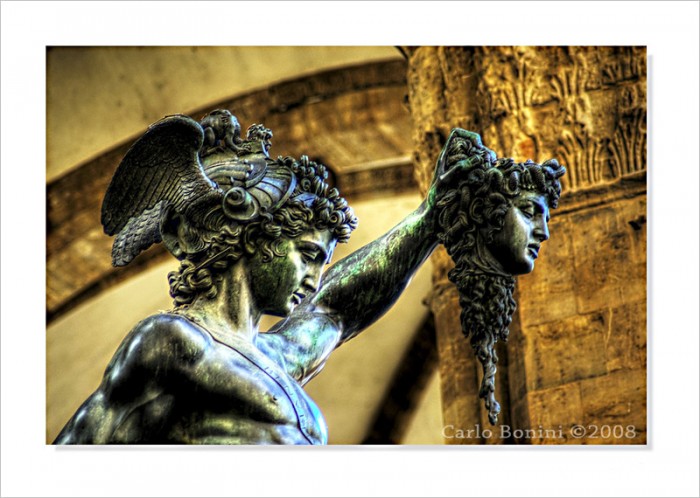Perseo Masterpieces in Florence
2013

Perseo and medusa – photo of Carlo Bonini
Florence is full of great masterpieces; Michelangelo’s David and Botticelli’s Birth of Venus, to name just a couple. But there is one particular tale of Greek mythology that prompted the creation of not one but two masterpieces in Florence. The tale of Perseo and Medusa influenced Cellini’s Perseo and Medusa statue, located in the famous Piazza della Signoria, and also Caravaggio’s Medusa head painting, which can be found in the Uffizi museum in Florence.
So what exactly is the story of Perseo and Medusa? Well, the king of Argos was informed by an oracle that he would eventually be killed by his own grandson. So to try and prevent this, he cruelly imprisoned his only daughter Danae. But Zeus came to the rescue, and in the form of golden rain, he pierced through the walls of her prison and also impregnated her. Following this, Perseus was born, and mother and son were then abandoned at sea on an ark. Luckily, they arrived at Serifos Island, where they were rescued by the King of Serifos’s brother.
Perseus grew up into a strong young man, and the King of the island decided he quite fancied Danae, and wanted her for his wife. To get Perseus out of the way, he sent him on a dangerous mission; to bring back the head of the gorgon Medusa. Perseus armed himself with winged sandals, a sword, an invisibility cap and most importantly, a mirrored shield; so he would not be turned to stone by looking directly at Medusa’s face. He succeeded in cutting off her head, and heroically returned to the island with it.
This tale of Greek mythology has had a very powerful artistic significance throughout history, and still influences artists today. The Medusa by Caravaggio was painted in 1597, and truly demonstrates his ‘natural’ style, while at the same time being fantastic. As you gaze at the painting, you’ll be horrified by the lifelike snakes wriggling on Medusa’s head, and by her shocked expression. Cellini’s bronze statue on the other hand, while less horrific, is still incredibly dramatic.
Located outdoors in the Loggia dei Lanzi in Piazza Signoria, this 1545 sculpture is surrounded by 3 other important statues of men who, rather fittingly, are all made of stone. Both artists had their work commissioned by the powerful Medici family, who loved this heroic story, and in this Medici dominated Piazza, wanted this tale of Greek mythology represented. Caravaggio’s painting was meant to represent the Grand Duke’s courage in defeating enemies, although it’s fairly certain that the Duke himself didn’t face any monsters with snakes for hair…
Check out our Palazzo Vecchio and Piazza della Signoria tour to explore and learn about these historic areas, and gain a wonderful insight into this legend loving family and their many artistic commissions.
